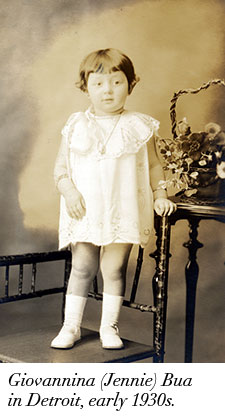 The series of lace designs I've been naming after beloved women in my family (it began with Sahar and continued with Pauline) has a new addition: Giovannina.
The series of lace designs I've been naming after beloved women in my family (it began with Sahar and continued with Pauline) has a new addition: Giovannina.That was my maternal grandmother's given name, as recorded (to our collective surprise) on her birth and baptismal certificates. She never used it, and neither (so far as any of us recall) did her mother. She was called Jennie, and called herself Jennie, and signed my birthday checks (thank you, Grandma) Jennie.
She was born in the early 1930s in Detroit, Michigan, to parents who had immigrated from adjacent Sicilian towns but married (in a match arranged by their families) in the United States. On the day of their wedding my great-grandmother was a few days shy of 16.
Giovannina was the third of four children and the first of two daughters. She fell in love with a nice Sicilian boy from New York City and went on to have five children of her own - four daughters and a son.
The priceless image below was taken before my arrival in the 1970s, but it's a fair representation of how I remember her.
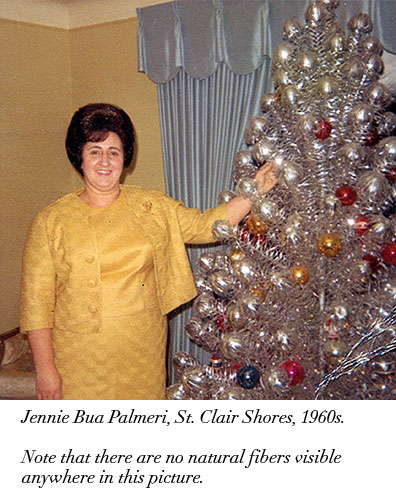
The Christmas tree was in the front room of the house in St. Clair Shores, a suburb of Detroit. In the local patois this space was invariably referred to as the "frontroom"–one word. It was reserved for state occasions: Christmas morning, wedding photos, visits from clergy, official visits from my mother's gentlemen callers–including, eventually, my father.
When I think of my grandmother, I think of this room. She decorated it herself, and it was filled with her favorite things. When she wanted new furniture for it, she did the unspeakable for a good Italian wife in that time and place–she went out and got a job to pay for it.
The front room was a textbook example of what I affectionately call Dago Baroque. Imagine the crossing of St. Peter's in Rome, but with top-of-the-line seven-layer curtains from J.C. Penney and pale yellow deep-pile shag that never, ever has vacuum marks in it.
The gigantic furniture, including the console record player, was French Provincial upholstered in white damask under clear plastic. The wallpaper was gold foil with green flocking. You could see yourself in it. It remained absolutely pristine for decades until the never-to-be-forgotten morning when one of my cousins accidentally smacked it with a wet lollipop. Years later, Grandma still could not refer to this incident without turning red.
Bric-à-brac of the most elevated variety covered every horizontal surface. The customary painted miniature pony cart, of course; and a cabinet stuffed with a prized collection of porcelain angels and bells.
I now own two of the other major pieces: an 18-inch high Infant of Prague with a metal crown and a full seasonal wardrobe; and a hefty cut-glass candy dish on a marble base guarded by a pair of gilt cherubs. There was one other candy dish - a white marble urn with birds perched on the rim. The former held ribbon candy, the latter green and pink pillow mints. The stuff was so vile that sneaking it when the grown-ups weren't looking wasn't even worth the risk. When my grandmother died in the late 1990s, the candy in the dishes is believed to have been the same that was already installed when my mother was a bride in the late 1960s.
There were also, on pedestals, a pair of plaster statuettes of Italian peasants lugging huge baskets of velveteen grapes. My father was parked in an adjacent armchair chair near these on his formal visit, while my mother stirred pasta in the kitchen and presumably begged her parents to go easy on this one. After a while the eligible bachelor got bored and started shooting spitwads into one of the baskets. My mother caught him and happily was able to clear away the evidence before my grandmother could get wise and throw him into the street.
I loved my grandmother, and as a child I loved this room because it was so beautiful and brilliant and untouchable. I used to stand by the door and just stare across the threshold. On occasion, because I was such an odious little goody-goody, I was allowed to sit quietly on the sofa and just look at things. Just look, not touch. If I so much as extended a tentative finger toward the incredible cover of the Bible on the coffee table (with an inset reproduction of Leonardo's Madonna and Child with Saint Anne) she would shout from the laundry room in the basement, "I told you, don't touch!"*
I had an epiphany in that room. Not a pleasant one, either. My mother and I drove in for a visit. I was in my mid-twenties, and we were there specially to see my grandfather, who was ill with the condition that would eventually kill him. He had been moved from the bedroom to a hospital bed in the family room (a later addition, off the kitchen). My grandmother, unable to face her wedding bed without her groom...had taken to sleeping on the Sacred White Couch in the front room. While we were there, she ceded that space to me. The plastic furniture covers were gone. There were clothes thrown in a corner near the glass cabinet, and bottles of pills scattered on the coffee table by the candy dish.
I was shocked. It was the first time that I realized that certain people and things you thought would always be there, unchanging–Grandpa, Grandma, Grandma's sitting room–are not as eternal as you would wish. It was the moment I first understood, viscerally, that nothing is forever.
I can't claim that I consciously intended it, but when I started working with the lovely Filigran (100% merino superwash) that Skacel sent to me with a request for a lace design, these memories of my grandmother manifested in the square motif that became the main element in the stole. It's ornate, but orderly.
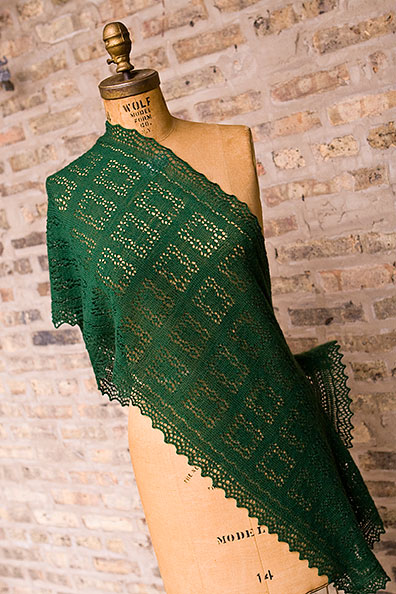
I hope she would have liked it, though she was not one for wearing shawls. (She did like drapey flowy gowns, though, and bought one or two each year for my grandfather's annual convention in Las Vegas.)
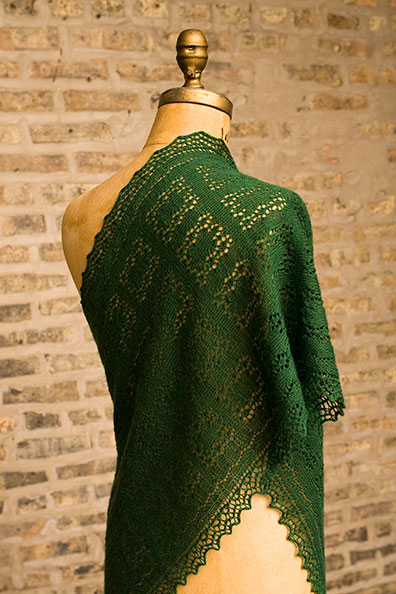
The construction's a bit unusual, by the way. I took inspiration from the eminently sensible technique of the Orenberg lace knitters–who work their shawls in one piece, center and edging simultaneously. The method for turning the corners is different, but the end is the same: when the shawl is finished, it's finished. You have a center completely surrounded by a lacy edge, with nothing else to do but wear it.
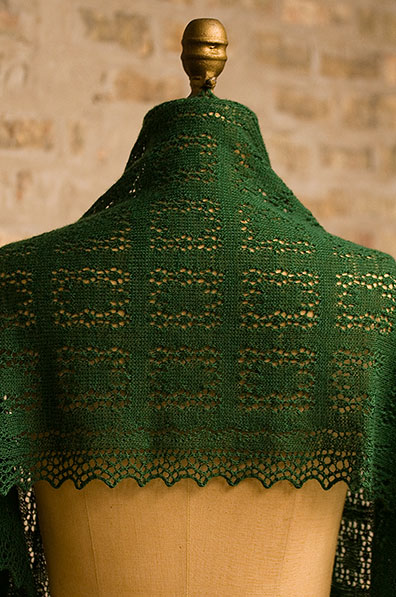
Skacel wholesales their pattern collection to yarn retailers everywhere, so if you'd like a copy, contact your LYS. If you run (or know of) a shop that's got Giovannina in stock, please feel to speak up in the comments. If you'd like to ask your shop to place an order, the pattern number is 21100405.

*My mother has inherited this supernatural ability to see through solid surfaces, as well as the skill to effortlessly stun small children with it.


